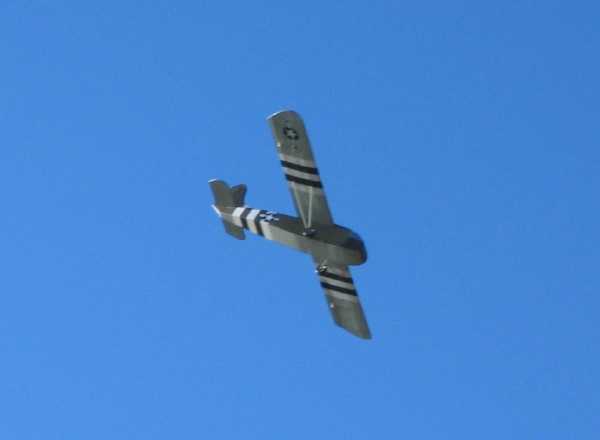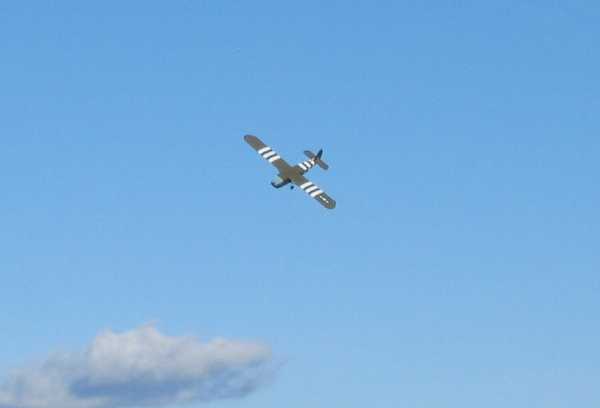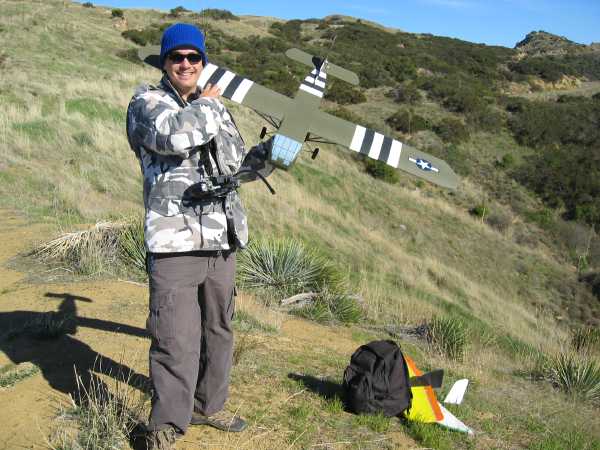|
Flying The Waco CG-4A
Updates 1/31/04:
It's all done, struts and everything. Looks great in the air and flies just fine!



Movies of the Waco available here:
Updates 1/16/04:
I've had a chance to fly the Waco a few more times since I wrote my initial flying impressions below.
Since then, I've had a chance to fix the incidence problem and take out a bit of wing warp that had shown
up at some point. The Waco is now flying VERY well!
While I'm happy with the speed it is capable of, I'm pretty sure it flies a bit too fast to really
look scale--I hope Carl Gwartney will forgive me! Despite that the plane is very satisfying to fly,
and as noted below it is quite stable. Stalls are well-signalled and easy to recover from, and low speed
handling near the ground is good.
What has really impressed me is that I think the Waco will actually fly in much lighter lift than I
had originally anticipated. While I've not flown it in such conditions yet, it's behaviour leads me to
believe that it will probably hang in there even on the lighter days around here in Santa Barbara, and I
suspect it could pick up some thermals on a really booming day. But we'll see about that--may just be
wishful thinking on my part!
I've tried using spoileron mixing just to see what it would be like, but honestly I've found that they're
not particularly effective on this model. It does only have half-span ailerons, after all; they mostly serve to
pitch the nose upwards, though they do help slow it down somewhat. I will continue experimenting with them,
but I suspect the most effective means of getting the plane down is by sideslipping it, just like the fullsize
version. I'm quite happy I built it with a rudder because practicing slip approaches is really a blast!
Overall, after more flight time I'm still amazed that my first scratchbuild project produced an airplane that
flies this well. While the scale dimensions of the plane could stand some improvement (next time I will only use
ONE set of plans to build from--not three!), I think the end result is a very nice flying stand-off scale glider.
I can only imagine what a big three or four meter version would fly like...the mind boggles!
Original flying impressions:
Transcribed from this thread
on RCGroups.com:
I was pretty much expecting this thing to be a big, mellow
and cruisey floater-type plane...you know, a pig. The Waco
didn't disappoint! I'm happy to report that I think it flies
very "scale", really looking the part of an invasion glider
even without any sort of trim detailing whatsoever.
It's got half-span ailerons, so even with 125% EPA, the
roll rate is somewhere in the vicinity of 1 roll every five
seconds--a bit of a change from the mini Patton which is
just about the inverse! The AUW came to 49oz., which gives
the plane a wingloading of just under 14oz./sq.ft. (wingspan
is 63", chord is 8.25"). But it flew like it was really
"light"; the first thing that came to mind was "Olympic
650 with ailerons". And I don't mean that in a bad way at
all. I think it could definitely use some ballast, however.
The biggest problem the plane had was the incidence. I
built it with the leading edge of the wing at about a 2*
positive angle of attack, and the stab flat. I've since
learned that 0*/0* probably would've been the way to go...my
elevator had about 15* of down trim in it, just in order
to fly level in the powerful lift at Cajon. When I got the
speed up the plane really started to balloon (pitch up),
and I don't think it's noseheavy. Oooops!
I realized on the way home, however, that when I put the
landing gear and wing struts on, the extra drag created
might have some influence on this pitch-up tendency. So
I may leave the stab as-is until I get a chance to fly it
with the struts on at least. If the plane responds the same,
then I'll go ahead and give the stab some negative incidence
(i.e. give it a positive angle of attack) to match the wing,
and hopefully I'll see some more speed as a result.
Overall the plane flew great, insofar as it completely
met my expectations of it being a big, fat, and mellow cruiser.
I think it would make an awesome trainer (assuming you lived
close to Cajon anyways), being as it's very stable and forgiving.
For example, it auto-recovers in 1/2 turn from a spin initiated
with rudder and elevator, 2 turns from a spin with rudder,
elevator, and aileron--even if you keep holding the same
control inputs!
I'm glad I put the rudder on the plane. I was able to put
it into slips on final approach and pull off some pretty
sweet and smooth landings, which at Cajon can be a rather
dicey proposition. Spoilers would've been sweet, too, but
with the ability to slip this thing down, they're really
not necessary. Snap rolls are pretty cool, and the vertical
fin & rudder are large and effective enough (this model
was based off of an actual glider, after all!!) that you
can make nice "thermal" turns using just the rudder if you
like.
A surfing simile: if a standard PSS plane is like a modern
shortboard, the Waco is like a big, heavy singlefin longboard
from the '60s. It's all about cruisin' with this bad boy.
Which I really like--I've been pondering getting a floater,
and this is about as close as I'd honestly like to get,
so... mission accomplished!
All in all, I think the experiment of creating a pretty
scale model of a true warbird glider has proven highly successful!
The best part is of course landing...it's seriously just
like Normandy June 1944 all over again, this thing comes
in slow just like in the old movies. I check to see if a
squad of GI Joes are jumping out every time I walk up A
great deal of fun, and I'm so glad it's done--finally! And
it even flies OK, which is total gravy at this point!

|